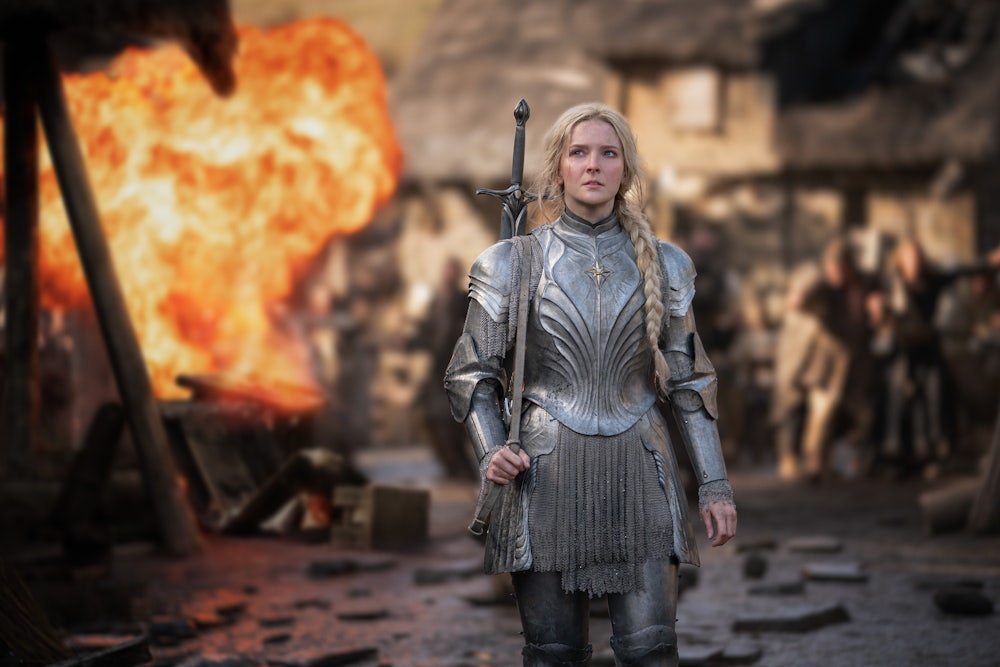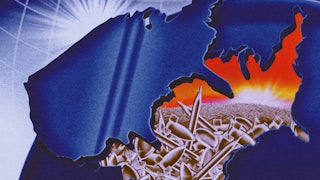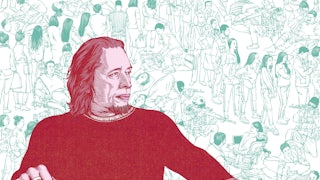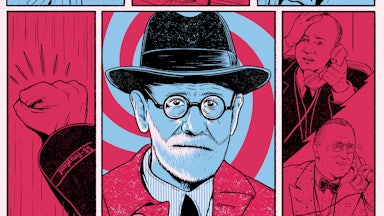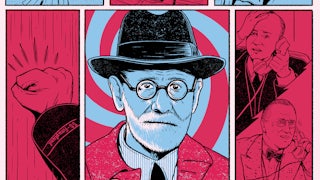The Lord of the Rings is a story born of war. J.R.R. Tolkien, the Oxford philologist from whose mind it emerged, first began writing the mythic histories that told the story of “Middle-Earth” after returning home from World War I’s western front, where he experienced the Battle of the Somme and succumbed to “trench fever.” He published The Hobbit in 1937 as Adolf Hitler was preparing his Blitzkrieg. Tolkien began writing The Lord of the Rings—a saga eventually released as three books: The Fellowship of the Ring, The Two Towers, and The Return of the King—soon thereafter, and during World War II sent early fragments of the saga to his son Christopher while the latter was stationed in South Africa. Finally, Tolkien completed The Lord of the Rings during the early Cold War, when it seemed to many that humankind stood on the brink of nuclear annihilation.
The echoes of war are heard throughout Tolkien’s epic. From Gandalf’s famous invocation to the Balrog, “You cannot pass,” which mirrors French General Robert Nivelle’s order to his troops that “you shall not let them [the Germans] pass,” to the many battles that pepper the trilogy, war permeates Middle-Earth. Even the story’s premise, which pits Good Hobbits against Evil Sauron, reflects the Manichean politics of the mid–twentieth century.
And The Lord of the Rings’s popularity has always been linked to war. In the United States, the books first became mass phenomena in the mid-1960s, when, according to The Washington Post, anti–Vietnam War hippies were attracted to the “parahipp[y]” Hobbits, “who live, smoke and eat peacefully.” Indeed, by 1967, “Frodo Lives” buttons were found alongside anti–Vietnam War buttons on college and high school campuses.
In my own youth, Peter Jackson’s Lord of the Rings film trilogy became a quintessential “global war on terror” saga. Released between 2001 and 2003, the films seemed to dramatize the Bush-era “with us or against us” struggle against radical Islamic terrorism/Islamofascism/jihadism/what-have-you. As The Washington Post wrote in 2002, when The Fellowship of the Ring debuted in December 2001, “conservatives saw it as an allegory of America’s new struggle against terrorism”; after all, “Osama bin Laden bears more than a passing resemblance to Tolkien’s villainous Sauron.” Eventually, Jackson’s trilogy grossed about $3 billion, with the final entry, The Return of the King, receiving the Oscars for best picture, best director, and best adapted screenplay, as well as the eight other awards for which it was nominated.
The
Lord of the Rings,
in other words, emerged from war and has historically been interpreted to
reflect U.S. attitudes toward war. And this remains true in 2022.
Amazon’s new Lord of the Rings show, The Rings of Power, is unique in the canon. Unlike the previously mentioned products, this new show does not tell tales found in Tolkien’s original epic but instead embodies something novel in this age of Hollywood intellectual property. But to understand why, we need to take a brief detour.
All of Tolkien’s writings about “Arda” (the world upon which the continent of Middle-Earth sits) take place during four “ages,” appropriately named the First, Second, Third, and Fourth Age. The Lord of the Rings occurs at the very end of the Third Age. The Silmarillion—the Old Testament-esque bible of Arda released in 1977, four years after Tolkien himself passed away—takes place mostly in the First Age. Tolkien wrote comparatively little about the Second and Fourth Ages, although he described the major events of the former before his death.
What Amazon has done, in effect, is purchase the 3,441 years that comprise the Second Age. For $250 million, the Tolkien estate has granted Amazon the right to tell stories in the Second Age, as long as these don’t violate the primary thrust of Arda’s history. Time, it turns out, can be bought.
The Rings of Power begins in the middle of the Second Age. In its broad strokes, the tale told in the first two episodes of the show reflects the one told in The Lord of the Rings. We learn in a prologue that the elves have defeated Morgoth, a primordial spirit who spent much of the First Age committing evil acts across Middle-Earth. Unfortunately for the elves, Sauron, Morgoth’s lieutenant and the soon-to-be lord of the rings, has escaped and is in hiding, presumably gearing up for an attack. But at the start of The Rings of Power, most of the Elvish elite is intent on placing its figurative head in the proverbial sand. Only one elf—our hero Galadriel (played by Cate Blanchett in Jackson’s movies; here played by the Welsh actress Morfydd Clark)—is committed, nay obsessed, with finding and killing the future Dark Lord of Mordor. Galadriel’s brother Finrod perished in the war against Morgoth, and she refuses to abandon her search for Sauron, as this would mean her brother’s death was for naught.
Though we meet a litany of characters in these first two episodes—the noble Elvish soldier Arondir, who loves the human Bronwyn; the daring Harfoot Nori (the Harfoots are proto-Hobbits); the annoying elf Elrond; the equally annoying dwarf Prince Durin IV, in addition to several others—the main plot centers on Galadriel’s struggle to ice Sauron.
While The Rings of Power tells the same basic story as The Lord of the Rings, in 2022 that story’s meaning has shifted in significant ways. In the 1960s and 1970s, the children of the counterculture imagined themselves as weed-smoking Hobbits defying “the man”/Sauron. In the 2000s, feverishly vengeful Americans imagined themselves as Aragorn hunting Osama bin Laden/Sauron. In both instances, the threat the audience wanted to depose was clear.
But
at the beginning of The Rings of Power, there is as yet no clear threat.
Morgoth has been defeated, and Sauron is nowhere to be found. The violence that
Sauron and his minions pose is theoretical, making Galadriel something of a
fanatic. Despite all evidence to the contrary, and despite literal centuries of
searching, she remains steadfastly devoted to annihilating Sauron, who may not
even still be alive.
Sauron thus faces no other choice but to fight. Even if he wanted to sue for peace and reach a diplomatic solution with the elves, Galadriel would never allow that to happen. For her, peace can only be built over Sauron’s dead body, which means that peace is never truly achievable.
And it’s here that The Rings of Power perfectly stands in for the ideology of the American empire in 2022. Galadriel embodies the fear and anxiety that defines U.S. power. For her, Sauron is less an enemy than a reason for being; if he didn’t exist, she would have to invent him. Galadriel cannot accept peace, just as the U.S. cannot accept peace, because she seeks certainty in a world defined by its opposite and because war is what makes Galadriel’s life meaningful. One gets the sense that even if Galadriel found and murdered Sauron, she’d keep searching for the next evil, lurching from crisis to crisis, from war to war, just like the U.S. did after World War II.
For both textual and metatextual reasons, the show is decidedly on Galadriel’s side. From the text, we, the audience, know that Sauron is, indeed, on his way back; the show depicts Sauron’s forces torching towns and trying to murder innocents. In the metatext, we also know that the elves will defeat Sauron, because he will return in the Third Age and be defeated again by Frodo, Sam, Gandalf, and the rest of the titular Fellowship of the Ring. Galadriel, the audience concludes, is right to go after Sauron. It’s never really a question.
In this way, the show reaffirms Galadriel’s, and by implication America’s, commitment to rooting out any (potential) evil wherever it might (potentially) arise. Contra The Lord of the Rings, whose heroes were blunt-passing, pacifistic Hobbits, The Rings of Power makes a fanatic its protagonist. It’s the perfect embodiment of the contemporary U.S. ethos. Though the U.S. faces no existential enemies—and hasn’t since 1945—we are constantly searching for one, justifying our search with reference to a mythologized past in which good guys defeated bad. If in 1968 Americans liked to imagine ourselves as the chill Frodo, and if in 2001 we preferred to think of ourselves as the righteous Aragorn, in 2022 all we can imagine ourselves as is the zealot Galadriel.
